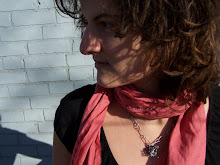It's been 9 months since my last blog post.
It's been 9 months since I conceived my first child.
I gave birth to that child 7 months ago, and mourned it's death.
Miscarriage is quite common. Statistics say that 1 in 4 women who get pregnant will experience miscarriage. When I was talking to other women about my experience, I was quite shocked to find out how many of them had experienced miscarriage(s).
I was very lucky that one of my friends had taken me aside while I was still pregnant, and shared her experience with me. When I was in the throws of miscarriage I knew who to turn to for support.

Miscarriage, in my experience, is quite the trip.
It started with some brown spotting. I started to panic, and looked online for some other reason that I might be spotting (some women experience spotting throughout their pregnancy). I found some information that said that stretching of the uterus may cause spotting, and I rested my worries with that.
A few days later the brown turned pink and I started to panic, but still I pressed on, thinking that everything would be fine.
On mother's day my partner took me out for breakfast to celebrate. I could feel my womb starting to contract, and felt exhausted. I couldn't deny it any longer. I expressed my feelings to my partner, and we shared and comforted eachother.
The next morning I was awoken by intense contractions or cramping. I was bleeding. I was in tears. We held eachother, crying for the little dream leaving our lives. Our roommate helped us get to the hospital. Once I sat down in the van my vision started to brighten to almost white, while my hearing became distorted, I felt weak. I wondered if I was dying. I said something like, "I can see how this could be a very beautiful experience if it were a joyous living birth." Walking into the hospital, I was unable to interpret much beyond what was happening with my body I remember saying "Here it comes" as I felt another rush release from my womb.
I now know that if I ever need to have a hospital birth I will have no problem expressing myself and doing what I need to do. I spent the hours in the waiting room squating, toning, and moaning through contractions, crying, sitting on the floor, doing partner yoga with Dave, and loudly complaining that the tea vending machine did not offer any herbal teas.
The next few days were spent bleeding on the Earth in our backyard, drinking wine, (Ciao seemed to be an appropriate choice), reflecting, rebirthing, ritualizing, and finding comfort in the loving people that surrounded me. This process was very healing, and I was able to come out with some valuable insights. I know that everything happens for a reason, and I can see that it just wasn't the right time. I also know that
that journey needed to happen I have learned so much in the past 9 months. There have been many changes in my life, and much transformation. I am taking care of myself, and being conscious of my body, mind, and spirit. I still work hard, but I make sure that I am feeling balanced
Freedom-Sage will always be part of our family, and has had a deep impact on who we are and how we've changed.
Dave and I hope to bring a child to this world one day, and share our lives with them in a way that is nurturing and sustainable.
I plan on incorporating miscarriage into my activities with Sustainable Cycles (www.sustainablecycles.ca). I feel like I have a lot to offer with support and healing. I feel that writing and talking about my experience is healing, not only for me but for others who has or will experience rite of passage.







